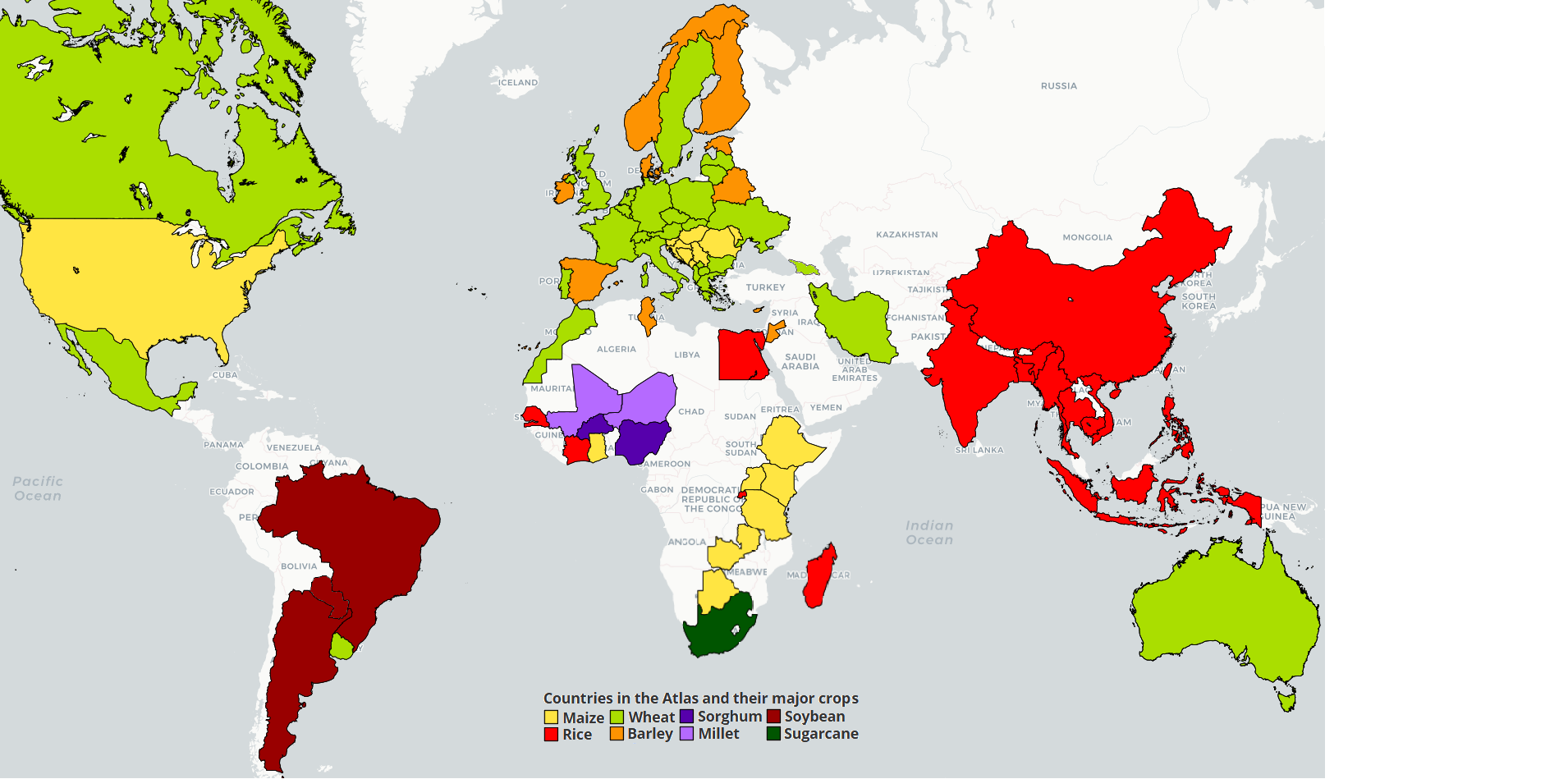 Kenya
Kenya
Detailed information on the analysis by crop is available for:
- Maize. Please check the sub-Saharan Africa maize page
- Wheat. Please check the sub-Saharan Africa wheat page
- Sorghum. Please check the sub-Saharan Africa sorghum page
- Millet. Please check the sub-Saharan Africa millet page
Description of cropping systems, climate, and soils in Kenya (by Dr. O. Adimo)
Agriculture remains the mainstay of the Kenyan's economy, providing 26% of the GDP, and 80% of the rural population derives their livelihood from agriculture and other related activities. It is also the nations' top earner of foreign exchange, contributing about 60% of export earnings. Farms in Kenya range from small-scale subsistence family operations to large-scale mechanized enterprises with crops and/or livestock.
Kenya's total land area is about 587,000 km2, of which 576,076 km2 consists of land and 11,230 km2 is covered by water. Of total land area, 18% has a high to medium agricultural potential. The rest is arid and semi-arid land (ASAL) and, therefore, of low agricultural potential. Kenya has six agro-ecological zones as given in Table 1.
Table1: Agro-ecological zones of Kenya
| Zone | Appr. Area (km2) | % Total |
| I. Agro-Alphine | 800 | 0.1 |
| II. High Potential | 53,000 | 9.2 |
| III. Medium Potential | 53,000 | 9.2 |
| IV. Semi-Arid | 48,200 | 8.5 |
| V. Arid | 300,000 | 52.9 |
| VI. Very arid | 112,000 | 19.8 |
| Rest (waters etc) | 15,600 | 2.6 |
Source: Sombroek, et al., 1982.
Of total ASAL area of 48 million ha, 24 million ha is only useful for nomadic pastoralism; the rest can support some commercial ranching and irrigated agriculture but with added technological input. Over 7 million people live in and derive their livelihoods from ASAL areas; the remaining population lives in the high to medium agricultural potential land areas or in cities. In a country where 80% of the population depends on agriculture, the high and medium potential areas have been split up into to small-scale farms of up to 0.5 – 10 ha. For example, 81% of the small-scale farmers occupy holdings of less than 2 ha. Considering that the population growth rate is 3.2%, pressure on the land is continuously reducing the capacity to sustain food production and cash crop-farming. Despite these problems, Kenya is a leading producer of tea and coffee, as well as a major exporter of fresh produce, such as flowers, vegetables and fruits. Small farms mostly grow maize and sometimes also potatoes, bananas, beans and peas. Table 2 gives the areas, production and yields for the major food crops in Kenya.
Table 2: Average (2010-2011) production, harvested area and yield of major food crops in Kenya
| crop | Harvested Area (ha) | Total Production(t) | Yield (t ha-1) |
| Maize | 2159322.0 | 4089043.2 | 1.9 |
| wheat | 148,703.0 | 444373.6 | 3.0 |
| Barley | 21,827.0 | 72930.6 | 3.3 |
| Beans | 1,055,632.0 | 613902.0 | 0.6 |
| Rice | 25,197.0 | 92696.0 | 3.7 |
| Sorghum | 223,799.0 | 166626.9 | 0.7 |
| Millet | 118,289.0 | 74915.8 | 0.6 |
| Cowpeas | 214,492.0 | 113802.8 | 0.5 |
| Green grams | 188,416.0 | 91824.3 | 0.5 |
| Pigeon peas | 143,212.0 | 89390.1 | 0.6 |
| Irish potatoes | 135924.4 | 1846576.0 | 13.6 |
| Tomatoes | 18115.9 | 395297.8 | 21.8 |
| Cabbages | 19491.0 | 891771.0 | 45.8 |
Source ; Agriculture Economic review 2012
Kenya has a wide range of soil types, which is caused by large variation in geology (parent material), relief and climate. Soil types vary from sandy to clayey, shallow to very deep, and from low to high fertility. However, many soil types have serious limitations such as salinity, sodicity, acidity, fertility and drainage problems. The major soil types used in agriculture are ferralsols, vertisols, acrisols, lixisols, luvisols and nitisols.
Food crops and other annual crops are grown according to rainfall amounts and temporal distribution, which is bimodal in nature. The long rains occur from March to and including May, while the short rains occur from October to and including December. Following these rainfall patterns, annual single-crop systems and double-crop systems can be found.
References
Economic Review of. Agriculture. 2010. REPUBLIC OF KENYA. Ministry of Agriculture. Prepared by: Central Planning and. Project Monitoring Unit.
Economic Review of. Agriculture. 2011. REPUBLIC OF KENYA. Ministry of Agriculture. Prepared by: Central Planning and. Project Monitoring Unit.
Economic Review of. Agriculture. 2012. REPUBLIC OF KENYA. Ministry of Agriculture. Prepared by: Central Planning and. Project Monitoring Unit.
FAO (1996). Agro-ecological Zoning Guidelines. FAO Soils Bulletin 73. Rom. www.fao.org
Sombroek, W.G., Braun, H.M.H. and van der Pouw, B.J.A. (1982). Exploratory Soil Map and Agro-Climatic Zone Map of Kenya, 1980. Scale: 1:1'000'000. Exploratory Soil Survey Report No. E1. Kenya Soil Survey Ministry of Agriculture - National Agricultural Laboratories, Nairobi, Kenya.
Gachene, C.K.K. and Kimaru, G. (2003). Soil Fertility and Land Productivity - A guide for extension workers in the eastern Africa region. Technical Handbook No.30. Regional Land Management Unit (RELMA)/ Swedish International Development Cooperation Agency (Sida). ISBN: 9966-896-66-X.
Legume production in East Africa
KenyaCommon bean is very important for the daily diet of many Kenyans, especially for the rural and urban poor. It is the main legume crop in Kenya, as it accounts for 67% and 56% of the total legume area and production, respectively (average of 2010 – 2014, FAOSTAT), and is important for the national economy (Economic Review of Agriculture, 2009). Pigeon pea accounts for 15% and 16% of the total legume area and production respectively, while cowpea accounts for 15% and 11% of the total legume area and production respectively (FAOSTAT).
Approach for yield gap estimation of grain legumes in Ethiopia, Kenya and Tanzania
Harvested area and actual yields
Distribution of crop area as reported by SPAM 2005 maps (You et al., 2014a; 2014b) was used.
Actual yields for Ethiopia were based on nine year district level data obtained from the Central Statistical Agency Ethiopia (CSA-Ethiopia, 2004-2016); for Kenya a 5-year average centered on year 2005 was obtained from SPAM 2005 (You et al., 2014a; 2014b); and for Tanzania four years (2003, 2008, 2013, 2015) of district level data from the National Bureau of Statistics Tanzania were used (NBS-Tanzania, 2012; 2016a; 2016b).
Selected climate zones and Reference Weather Stations (RWS)
In our set of 3 countries, there were 14, 22, 11, 10 and 13 buffers selected for, in the same order, chickpea, common bean, cowpea, groundnut and pigeonpea. In turn, these buffers were located in, respectively, 6, 11, 7, 6, and 6 different climate zones, which, overall, accounted for respectively 52, 43, 75, 89, and 70% of east Africa harvested area with these crops.
Weather data
In the selected buffers, long-term (1998-2012) daily weather data were retrieved from the National Meteorology Agency of Ethiopia (NMA, 1998-2012), Tanzania Meteorological Agency (TMA, 1998-2012), and Kenya Meteorological Department (KMD, 1998-2012). Since 52% of the buffers had less than 10 years of weather data but at least 3 years, long weather data records were generated using the method described by Van Wart et al. (2015). Finally, for buffer zones without any measured weather data (48% of total buffers), we used uncorrected gridded weather data from NASA-POWER.
Soil data
Soil data were retrieved from both AfSIS-GYGA functional soil information of sub-Saharan Africa database (maximum effective depth of water extraction from soil by roots, maximum soil depth, volumetric soil water content available for extraction by crop roots) (Leenaars et al., 2015; Leenaars et al., 2018) and ISRIC-World soil information, WISE international soil profile dataset (drainage) (Batjes, 2012).
Crop modelling
Water-limited potential yields were estimated using the generic crop growth model Simple Simulation Model for legumes (SSM-legumes) (Soltani and Sinclair, 2012; https://sites.google.com/site/cropmodeling/-7-ssm-soybean). The SSM model has been used to simulate growth and yield potential of a wide range of legume crops, including soybean (Sinclair et al., 2014; Sinclair et al., 2010), chickpea (Soltani and Sinclair, 2011; Vadez et al., 2013), common bean (Marrou et al., 2014), lentil (Ghanem et al., 2015), cowpea (Hissene et al., 2016), and groundnut (Halilou et al., 2016).
We collected the value of general plant parameters from previous model applications (Sinclair et al., 2010, 2014; Soltani and Sinclair, 2011; Vadez et al., 2013; Marrou et al., 2014; Ricaurte et al 2015; Guiguitant et al., 2017; Manandhar et al., 2017). In each of these studies, genotypes have been sampled to represent the diversity of genotypes used in each study environment, covering temperate, dry tropical, and humid tropical climates. Most plant parameters are known from preceding studies not to vary significantly within species. For the crop specific parameters, phenology and photoperiod sensitivity, we calculated them to portray the varieties grown in east Africa, by using the parameter values of genotypes of the same variety in preceding studies, or calculating them from the phenology reported by local agronomists.
More details and references are presented in: Loon, Marloes P. van , Nanyan Deng, Patricio Grassini, Juan I. Rattalino Edreira, Endalkachew Wolde-meskel, Frederick Baijukya, Hélène Marrou, Martin K. van Ittersum. 2018. Prospect for increasing grain legume crop production in East Africa. European Journal of Agronomy. Vol. 101 (November 2018), 140-148; https://doi.org/10.1016/j.eja.2018.09.004
Get access to the Atlas for advanced users
Download GYGA results
 | Please read the license information in case you are interested in using the data from the Global Yield Gap Atlas. |
| read more>> |


